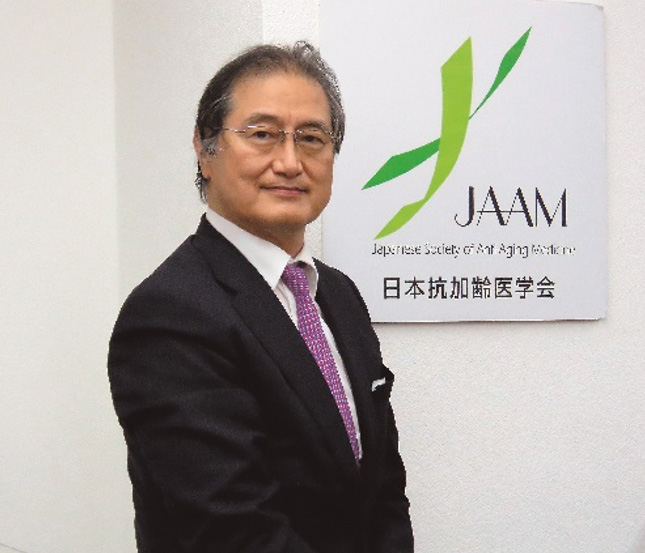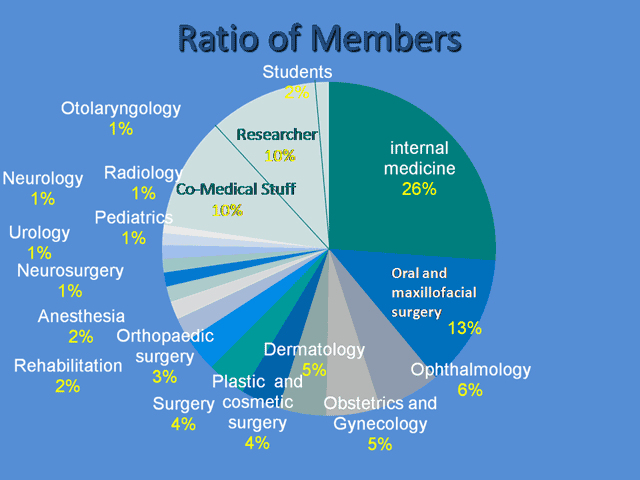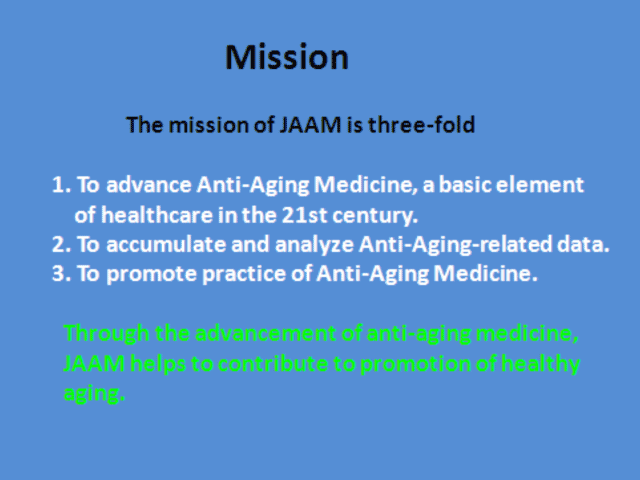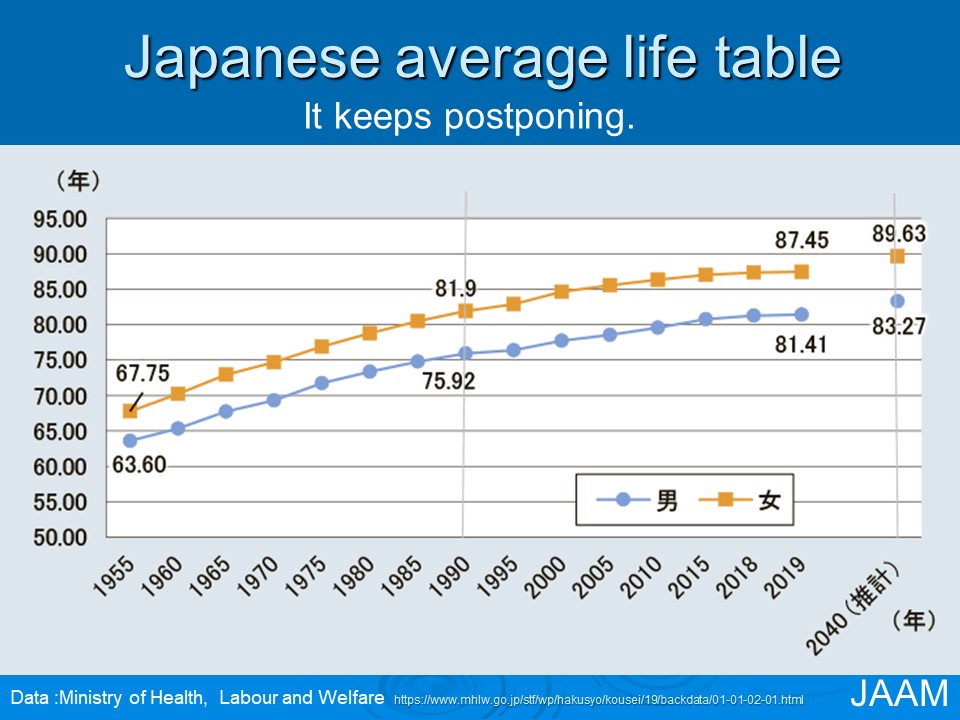Pursuing the Extension of Healthspan and True Rejuvenation — Integrating Anti-Aging Medicine and Aging Science

The Japan Society of Anti-Aging Medicine (JAAM) is one of the world’s largest academic organizations focused on aging, comprising over 9,200 healthcare professionals in Japan, one of the most aged societies globally.
Over the next 25 years, countries across Asia and Europe will also face rapid population aging, making scientific understanding of aging and corresponding interventions increasingly pressing international concerns. In response, the integration of “Anti-Aging Medicine”—with its clinical and preventive focus—and “Aging Science”, which centers on fundamental mechanisms, has become critically important.
In the West, terms such as Longevity Science and Aging Science have recently gained prominence, especially in the context of basic research and lifespan control. In contrast, Asia has nurtured a more practice-oriented academic field under the name Anti-Aging Medicine, deeply rooted in clinical applications and prevention. Understanding these cultural and disciplinary differences is vital to fostering global collaboration and mutual understanding.
Our society approaches aging as a “disease,” and we are committed to preventing age-related diseases, extending healthspan, and exploring the possibilities of true rejuvenation. Looking ahead to a future where aging may be officially recognized as a disease in the ICD (International Classification of Diseases), we are currently advancing evidence-based, personalized medicine and intervention strategies rooted in preventive medicine.
Recent progress in epigenetic clocks has revealed the potential to visualize and even reverse biological aging, both in vitro and in vivo—placing this research at the cutting edge of aging science.
At JAAM, we are developing comprehensive aging clocks that integrate not only cellular aging but also physical frailty, cognitive function, and subjective well-being. These clocks align with the WHO’s concept of Intrinsic Capacity, and will likely become a foundation for future aging and anti-aging medicine.
In clinical practice, age evaluation using DNA methylation clocks is now a reality, and multi-omics-based diagnostics and interventions are under development. Establishing aging clocks as treatment endpoints may represent a major paradigm shift.
International standardization of Longevity Clinics is also accelerating, especially in the UAE and Singapore, and our society has been actively contributing to this effort. Through initiatives such as standardized assessments including epigenetic evaluation, post-intervention outcome measures, and institutional criteria, we aim to help shape global standards from Asia. Looking ahead, we also envision building collaborative frameworks with countries across Asia and Europe.
Furthermore, the scientific separation between species-specific lifespans and modifiable aging is advancing. Research centered on epigenetics is rapidly gaining momentum, prompting a reconsideration of how we define rejuvenation—whether biologically, medically, or metaphorically.
At Expo 2025 Osaka-Kansai, our society is supporting the Osaka Pavilion, which will present the innovative concept of “shifting from chronological to biological age.” This initiative also aligns with the WHO’s efforts to address ageism, representing a concrete societal step forward.
In 2024, the fourth edition of The Basics and Clinical Applications of Anti-Aging Medicine, edited and supervised by JAAM, was published in English by Springer, enabling global knowledge sharing among healthcare professionals. In parallel, we continue to actively disseminate cutting-edge research through our partner journal, npj Aging.
Through our involvement in Expo 2025 and the XPRIZE Healthspan Competition, our society is committed to strengthening international outreach and global research collaboration.
JAAM’s membership includes not only physicians and dentists, but also pharmacists, nurses, registered dietitians, and physical therapists—professionals working in diverse settings. Achieving longer, healthier lives requires the collaboration and integration of multiple disciplines.
Moreover, the anti-aging medicine we advocate is not limited to geriatric care. It is a life course-based health science that spans from conception to the final stages of life. Thus, it is essential to promote preventive interventions at each life stage, support healthy lifestyle habits, and offer science-based education and public awareness.
As part of this effort, we will soon launch a new program tentatively titled the “Anti-Aging Certification Exam”, designed for the general public. This initiative will help more people acquire evidence-based knowledge about aging prevention and empower them to live proactively in the era of 100-year lifespans.
We have also established certification systems for anti-aging specialists, instructors, and accredited facilities. Our structured training programs—including lectures and e-learning—are highly regarded both in Japan and overseas. About half of our members attend our annual meetings, and we plan to further promote multilingual presentations and global expansion.
Looking forward, it is our mission to share the insights of Japanese-led Anti-Aging Medicine and Aging Science with the world, contributing to the well-being of humanity and the extension of global healthspan.
We warmly invite you to join us in building the future of medicine—together.
Hidekazu Yamada, M.D., Ph.D.
President, Japan Society of Anti-Aging Medicine
1.About Japanese Society of Anti-Aging Medicine(JAAM)
 The Japanese Society of Anti-Aging Medicine (JAAM) initially founded as the Academy of Anti-Aging Medicine Japan with 20 doctors in 2001. It was then reorganized as JAAM in April 2003, and incorporated as a limited liability intermediate corporation in July 2006.
The Japanese Society of Anti-Aging Medicine (JAAM) initially founded as the Academy of Anti-Aging Medicine Japan with 20 doctors in 2001. It was then reorganized as JAAM in April 2003, and incorporated as a limited liability intermediate corporation in July 2006.
With a membership of more than 8,200 individuals covering a wide and diverse range of basic research and clinical specialties, JAAM has grown into one of the largest academic societies dedicated to the advancement of Anti-Aging Medicine in Japan.
Anti-Aging Medicine deals with the biological process of aging. It aims to prevent diseases, including lifestyle-related diseases; to control factors that promote the occurrence of disease, including stress, fatigue, and immunological deterioration; and to promote and prolong a healthy life span. Insights yielded in this field are also helpful in scientifically elucidating phenomena occurring in biological processes throughout life, from birth to death.
 From the genetic and cellular level to the individual level of animals and humans, Anti-Aging Medicine covers diverse fields of medical science, including biochemistry, physiology, and clinical medicine, and takes a multidisciplinary approach involving chemistry, physics, agriculture, pharmacy and others.
From the genetic and cellular level to the individual level of animals and humans, Anti-Aging Medicine covers diverse fields of medical science, including biochemistry, physiology, and clinical medicine, and takes a multidisciplinary approach involving chemistry, physics, agriculture, pharmacy and others.
Research results are utilized in the practice of Anti-Aging Medicine, which is supported by replacement herapy based on nutrition and endocrinology, and lifestyle improvement, including physical exercise and rest.
The clinical practice of Anti-Aging Medicine can be approved only when it is validated on the basis of scientific evidence. In this context JAAM pursues the practice of Anti-Aging Medicine that is scientifically evidence-based.
2. Mission
 The mission of JAAM is three-fold: to advance Anti-Aging Medicine, a basic element of healthcare in the 21st century, to accumulate and analyze aging- and anti-aging-related data, and to appropriately approve practice on the basis of scientific evidence, thereby promoting the practice of Anti-Aging Medicine.
The mission of JAAM is three-fold: to advance Anti-Aging Medicine, a basic element of healthcare in the 21st century, to accumulate and analyze aging- and anti-aging-related data, and to appropriately approve practice on the basis of scientific evidence, thereby promoting the practice of Anti-Aging Medicine.
Through the advancement of Anti-Aging Medicine, JAAM helps contribute to improving the well-being of people everywhere.
3. Establishment
 In 2001, the year when the Academy of Anti-Aging Medicine Japan was established, the coming of the aging society was already foreseen, with fewer children and marked increases in medical costs for the elderly. The universal healthcare system of Japan was expected to come under pressure, with many anticipating a change in policy and direction. In theses circumstances and amid the advance in research into aging and related phenomena, the Academy of Anti-Aging Medicine Japan was founded by physicians and researchers to make active use of Anti-Aging Medicine, in both basic and clinical medicine, and encourage prevention of the pathological processes of aging, thereby improving quality of life.
In 2001, the year when the Academy of Anti-Aging Medicine Japan was established, the coming of the aging society was already foreseen, with fewer children and marked increases in medical costs for the elderly. The universal healthcare system of Japan was expected to come under pressure, with many anticipating a change in policy and direction. In theses circumstances and amid the advance in research into aging and related phenomena, the Academy of Anti-Aging Medicine Japan was founded by physicians and researchers to make active use of Anti-Aging Medicine, in both basic and clinical medicine, and encourage prevention of the pathological processes of aging, thereby improving quality of life.
Anti-Aging Medicine contributes to promoting and prolonging a healthy life span, reducing increases in medical expenses for the elderly, extending productive age, and securing an adequate workforce, all of which should be part of a national strategy.
Reorganized as the Japanese Society of Anti-Aging Medicine (JAAM) in April 2003,
we continue to dedicate our best efforts to the accumulation of precise data, dissemination of accurate information, and the establishment of Anti-Aging Medicine as an evidence- and fact-based discipline which is approved and accepted by the medical community and society as a whole.
4. Research of Anti-Aging Medicine
・Insights yielded in this field are also helpful in scientifically elucidating phenomena occurring in biological processes throughout life, from birth to death.
・Anti-Aging Medicine deals with the biological process of aging.
It aims to prevent diseases, including lifestyle-related diseases; to control factors that promote the occurrence of disease, including stress, fatigue, and immunological deterioration and to promote and prolong a healthy life span.
・From the genetic and cellular level to the individual level of animals and humans, Anti-Aging Medicine covers diverse fields of medical science, including biochemistry, physiology, and clinical medicine, and takes a multidisciplinary approach involving chemistry, physics, agriculture, pharmacy and others.
・Research results are utilized in the practice of Anti-Aging Medicine, which is supported by replacement therapy based on nutrition and endocrinology, and lifestyle improvement, including physical exercise and rest.
5. Subcommittees
Anti-Aging Medicine of Ophthalmology
Anti-Aging Medicine of Dental Medicine
Appearance for Skin and Beauty
Anti-Aging Hormone
Anti-Aging Medicine of Urology
Anti-Aging for Women’s Health
Anti- Aging Medicine of CVD
Anti- Aging Medicine of locomotorium
6. Progress and future of Anti-Aging Medicine
・How to activate GDF-11.
・Genomic Medicine
・SmartCare
・Solve physical and mental problems that are factors preventing elderly people from participating in society.
・Reduce medical expenses






